
There are tons of color combinations that Discus fish comes in extracted from the four major color strains from which these other color morphs emerge. The four colors include heckle, brown, blue, and green.
Table of Contents
- Discus Fish Colors And Shades
- 54 Discus Full-Colors And Shades List
- Ghost Discus
- White Butterfly Discus
- Snow White Discus
- Pigeon Blood Discus
- Tiger Turkish Discus
- Heckel Cross Discus
- Red Marlboro Discus
- Red Melon Discus
- Red Cover Discus
- Red Valentine Discus
- Checkerboard Red Valentine Discus
- Red Turquoise Discus
- Snow Leopard Discus
- Spider Leopard Discus
- Red Snakeskin Discus
- Albino Leopard Snakeskin Discus
- White Leopard Discus
- Albino Leopard Discus
- Checkerboard Turkish Discus
- Checkerboard Pigeon Blood Discus
- Checkerboard Red Map Discus
- Albino Golden Discus
- Golden Checkerboard Discus
- Albino Platinum Discus
- White Scorpion Discus
- White Dragon Discus
- Fineline Snakeskin Discus
- Leopard Spotted Discus
- Pigeon Snakeskin Discus
- Rose Red Discus
- Super Red Melon Discus
- Blue Diamond Discus
- Blue Snakeskin Discus
- White Diamond Discus
- Albino Snakeskin
- Yellow White Discus
- Millennium Golden Discus
- Albino Green
- Albino Turquoise
- Cobalt Blue Discus
- Leopard-Skin Discus
- Golden Marlboro Discus
- Golden Leopard Snakeskin Discus
- Brilliant Blue Discus
- Solid Blue Discus
- Golden Crystal Discus
- Rot Turkish Discus
- Leopard Snakeskin Discus
- Ring Leopard Discus
- Mosaik Leopard Discus
- Red Sun Discus
- Mercury Discus
- Red Diamond Discus
- Tiger Pigeon Discus
- Related Questions
- Conclusion
Discus Fish Colors And Shades
Discus fish colors are numerous; however, these various colors can be grouped into 3 main classifications that all Discus colors can be grouped into those 3 classifications which include:
- Solid colors – These are fully striated with a single color.
- Mildly patterned – These are discus that has large points over their bodies but they are not much.
- Strongly patterned – Discus that is strongly patterned have a lot of small points scattered over their bodies.
There are a lot of subspecies of discus combined by the above 3 classifications, be that as it may, four major subspecies are very noticeable as all the others are derived from these four. They include:
Heckle Discus (Symphysodon Heckel):

- This was the first discus to be discovered and it was discovered by Johan Heckel and was later on named after him. This discus comes in two variants – a red and a blue and each of these variants has a dark stripe going down the middle of its side. It is also known as the Pompadour Fish.
- The variant of this discus having a red color commonly referred to as “Red Heckel or Red Discus” is one of the major attractive naturally occurring types of discus fishes.
- You can easily spot out a heckle discus from a variety of discus fishes because they have a special quality that distinguishes them which is three bold vertical vars – one of these bars is running from the eye, another through the caudal fin, while the last one which is the most noticeable is the one at the middle of its side.
- The heckle discus has more of a round shape than any other discus, they have greenish-blue veins that run through their bodies, and most of the time the color of the fish is the same as the color of their fins, however, the caudal fin and pectoral fin may be vibrant.
Brown Discus (Symphysodon Aequifasciata Axelrodi):

- Despite the fact that there are varieties of this strain, one thing that is common is that their bodies are usually yellowish-brown in color and they have chatoyant spots and stripes that cover their bodies; the color of the dorsal fin and the anal fin are blue-green to red, while the caudal fin is typically vibrant.
- Brown discus usually have long and slim pelvic fins as well as transparent pectoral fins.
- The brown discus is in actuality a subspecies of the green discus and a lot of them are imported from the southeastern part of Asia.
- The hue of a brown discus that is being kept in an aquarium is usually has a deeper red color than that of discus that was caught in rivers. Brown Discus is the most popular discus.
Blue Discus (Symphysodon Aequifasciata Haraldi):
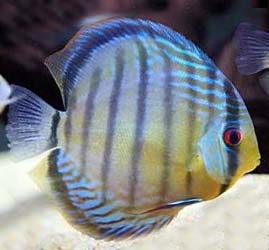
- The color of the body of the blue discus is solid ranging from yellow-brown to light greenish-blue while the anal fin and dorsal fin have a deep iridescent blue color or red color.
- There are greenish-blue markings that go through the head of the blue discus as well as its upper body parts.
- Blue discus has variants as well; there is the royal blue variant that has unique blue markings on the body and then there’s the red royal blue discus which has both red and blue lines on its body.
Green Discus (Symphysodon Aequifasciata Aequifasciata):

- There are greenish-blue to blue lines that go through the head and upper parts of the body of the green discus.
- The color of the body is yellowish-brown and the lower parts of the body are covered with red spots.
- The anal fin and dorsal fin are greenish-blue and have red lines on them. Both the royal green and Tefé green variants have dark, vertical stripes on their body while the red spots on the Peruvian green variant are more than that of any other member of this species.
54 Discus Full-Colors And Shades List
In addition to the main original wild colors of Discus fish, eventually, other color combinations were bred in different countries thus the color combination cannot be calculated in one single resource since those colors are evolving every day, however, I have managed to show you 53 of the most common Discus colors combinations in the market below for your reference.
Ghost Discus

Ghost Discus having one light grey color with no stress bars and without spots nither on the body or the fins, it is considered very important for Discus fish breeders but not for the aquarist since Discus lovers care mostly about the bright colors other Discus have.
White Butterfly Discus
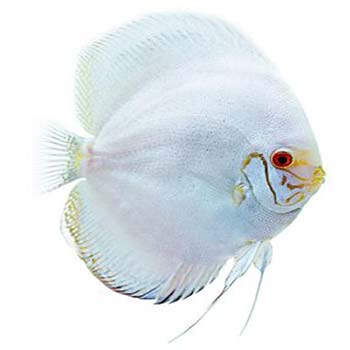
White Butterfly Discus is considered as one of the few popular Discus among Discus fish lovers, basically, this Discus fish has plain white color, they do have stress bars but they are the same white color of the body so when it comes stress they bar won’t be shown, it has different eye colors like orange, creamy and red.
Snow White Discus

Snow White Discus fish has nither stress bars nor spots or strips, while the body color is plain grey-white with bigger eyes than the other Discus fish.
Pigeon Blood Discus

Pigeon Blood Discus has a color ranging from creamy yellow to orange. It has bright red eyes and is covered with black stripes and points. The tail is mostly black in color and it is it was developed through a mutation in Thailand.
Tiger Turkish Discus
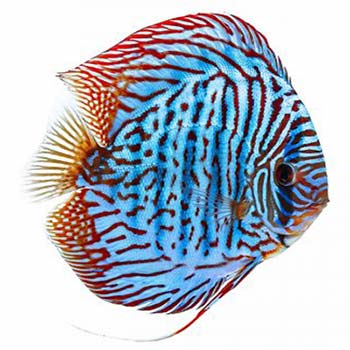
The Tiger Turkish Discus fish is widely known in German breeders, it has a beautiful combination of light blue color with dark strains and pigeon body design.
Heckel Cross Discus

Heckel Cross Discus is a new breed of Discus fish that has a black bar in the middle of its body along with other beautiful color combinations that most aquarists love.
Red Marlboro Discus

Red Marlboro Discus has yellow and red colors all over its body (the head is colored yellow or white and the body having a lively red color). They can be found in the Amazonian River of South America.
Red Melon Discus

The body of the Red Melon Discus is covered with a solid reddish-orange color; the head either has a reddish-orange color or pale yellow color. They also originated from South America.
Red Cover Discus

The Red Cover Discus colors are contrasted and mixed by yellows and reddish-orange colors, the face is a pale yellow color. Red Cover Discus colors are very unique to other Discus color combinations.
Red Valentine Discus

Red Valentine Discus has a valentine’s reddish color on most of her body area graded into red-orange color towards the top of its body and sometimes has white upper fins.
Checkerboard Red Valentine Discus

Checkerboard Red Valentine Discus combining part of a pigeon Discus body design with the same valentine’s Discus red color with a yellowish face.
Red Turquoise Discus

This discus has scarlet stripes over a chatoyant greenish-blue background. Its tail is shaped like a tangerine and the colors on the discus are vibrant. They are also native to the Amazon river.
Snow Leopard Discus

The background color of the Snow Leopard Discus is pale pink. It has light red leopard points on its body which lead up to the anal and dorsal fins after which it turns to translucent pink. It is a native of the Amazonian Basin.
Spider Leopard Discus

Spider Leopard Discus has an amazing Discus color combination of blue, red, yellow, and orange, all of these colors are combined in an artistic way in a leopard dots skin design.
Red Snakeskin Discus

The beauty of Red Snakeskin Discus is it’s having a snakeskin design over all the body and fins as well as the face, in addition to that having beautiful colors combinations of red, blue, yellow, and orange.
Albino Leopard Snakeskin Discus

Albino Leopard Snakeskin has leopard-like specks on its body and these specks merge to form stripes giving this discus a look like a zebra.
White Leopard Discus

White Leopard Discus has a distinctive pure white face and heavily dotted red color body with white fin edges.
Albino Leopard Discus

This Discus has an appearance ranging from white to light yellow and there are points on its body that give it a leopard’s appearance.
Checkerboard Turkish Discus

Checkerboard Turkish Discus has a unique color combination of a background color of light blue merged with distinctive orange striations crossed by black vertical stripes in the middle of the body as well as the head.
Checkerboard Pigeon Blood Discus
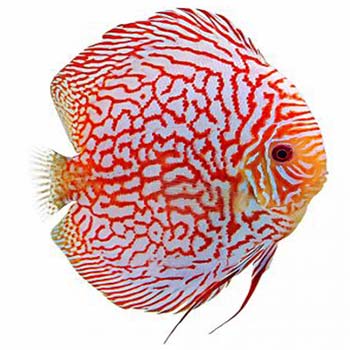
This Discus fish has a unique color of white intermingled with orange striations all over its body.
Checkerboard Red Map Discus

This special Discus has a unique blend of thick orange striations and blue color giving it a nice color tone.
Albino Golden Discus

The lower part of this discus is golden in color and the body is covered with white stripes. The pectoral and caudal fins are transparent. Their eyes are bright red in color.
Golden Checkerboard Discus

Golden Checkerboard Discus is distinguished by a gold color center in the body and striations of white and golden extending towards the fins and head, normally Golden Checkerboard Discus has a red eye.
Albino Platinum Discus

The opalescence of the dorsal and ventral fins of this discus is pink and the color of the body has slight shades of yellow on them; the color of their eyes is red.
White Scorpion Discus

This is a strain gotten from crossbreeding Blue Scorpion and White Pigeon discus. It has black specks on the body.
White Dragon Discus

This strain of discus has a pearl white body, striated with orange stripes and the head is an orange color.
Fineline Snakeskin Discus

As the name goes, the body of this Discus is patterned like a snake; the lower part of this fish is of a bright metallic Ocean Green hue.
Leopard Spotted Discus

This magnificent Discus fish has a special color combination and a mixture of blue, light blue, orange, and yellow with long black stress stripes in the middle of the body and the head, giving a leopard overall look.
Pigeon Snakeskin Discus

This is a strain gotten from crossbreeding Snakeskin and Pigeon Blood discus. The variants of this strain have blue, orange, red, and yellow specks on their body but the patterns are regular.
Rose Red Discus

Also called Red Rose Discus. It belongs to the same family as the Red Marlboro discus. It has Alenquer genes and the shade of red appears browner than other kinds of red discus.
Super Red Melon Discus

Super Red Melon strain is a member of the Melon line.
Blue Diamond Discus

This strain has a body covered with a lively chatoyant blue. This species mutates to form the Solid Blue and Brilliant Blue discus.
Blue Snakeskin Discus
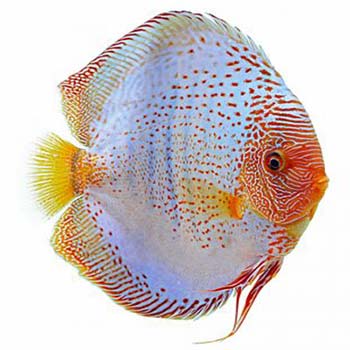
Blue Snakeskin Discus is unique having a lively coloring from the normal Striated Turquoise.
White Diamond Discus

This strain originated from the Amazonian Basin. An adult White Diamond is about 6 to 7 inches.
Albino Snakeskin

This has thin striations across its body with a lot of specks. It also has red eyes.
Yellow White Discus

This strain has a lot of specks on a yellow body. The head is white in color and it has red eyes.
Millennium Golden Discus

This Discus fish is distinctive from Yellow white Discus by the golden color tone of its body.
Albino Green

The body of the Albino Green discus is covered with a background color of marshmallow white and the area around its head is green.
Albino Turquoise

This strain has a body that is covered with blue and then upwards to the head is a pale green color.
Cobalt Blue Discus

Is also sometimes called Neon Blue discus. It is between 2 to 4 inches in size and is a native of the Amazon River.
Leopard-Skin Discus
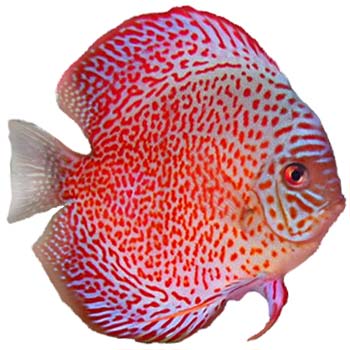
This discus is a result of crossbreeding mutated variants of the red-spotted green discus.
Golden Marlboro Discus

This strain has a yellow gold background color on its body and a pattern of white specks on it.
Golden Leopard Snakeskin Discus

Has burnt orange, red, and ochre specks on its body. Its head is gold but down to the tail, the golden color is a bit pale.
Brilliant Blue Discus

The body of this discus is covered in a somewhat metallic blue color. It is a mutated strain of the
Solid Blue Discus

Its body is solid blue in color and the color of its eye is red. Also, it has no stress bars or specks on its body. It is also a strain from the Blue Diamond discus.
Golden Crystal Discus

The abdominal area is pale moving other colors, sometimes orange or deep purple to the other parts of the discus such that it looks like a desert sun. Its face has an awash color and the pectoral fin is colorful.
Rot Turkish Discus

This special Discus type is normally bred in Germany breeding farms. It has a unique combination of colors giving it a nice appearance.
Leopard Snakeskin Discus

Thin striations cover the body of this discus and it has specks that also give it a leopard’s appearance.
Ring Leopard Discus

This Discus fish has a fascinating color combination of a blue gradient intermixed with red leopard design and orange eye.
Mosaik Leopard Discus

The Mosaic Leopard Discus has intricate leopard red spots on a blue hue background color giving it a distinctive appearance.
Red Sun Discus

This is a variant of the Red Melon and Red Marlboro strain. Its background color is red.
Mercury Discus

This strain has a luster that is a semitransparent pearl color that is almost celestial.
Red Diamond Discus

Red Diamond Discus is a must-have for Discus lovers due to its deep red color in its body with a lighter shade of red on its face.
Tiger Pigeon Discus

Tiger Pigeon Discus is part of the Pigeon Discus family distinguished with light blue background color and orange face with a black eye.
Related Questions
When Do Discus Develop Color?
Every discus requires two years to get their full color. At this age, their complete color of the body and body patterns will be developed completely and it will not be more vivid than at that age. A proper diet will help them grow and develop their overall color.
Why Does My Discus Change Colour?
In general, Discus could change its color in order to blend into its habitat, however, besides that, there are a number of reasons why Discus might change color and they include stress, fright, change in water pH and temperature, improper feeding.
Why There Are Darker Or Lighter Discus Colors?
Discus can be lighter or darker in color because of the appearance of the aquarium. They can change their colors in order to blend in with their habitat. Discus changes color to look like the color of plants or other objects in the aquarium or due to an ailment.
Is It Possible To Improve My Discus Colors?
Yes, there are several methods you can do to improve your Discus fish Colors.
Conclusion
Discus come in a wide range of colors that emerge from the four major ones which are Heckel, Green, Blue, and Brown discus; all the other strains are products of either mutation or crossbreeding these four.
Discus fish is able to change its color to adapt to its environment. It takes an average of 6 years for discus to reach its full pigmentation but they could reach their full color at the age of 2.
Some examples of these discus fishes include the Pigeon Blood discus, Cobalt Blue discus, Golden Marlboro discus, Red Marlboro discus, Leopard Skin discus, Red Melon discus, Red Rose Discus, Solid Blue discus, White Dragon discus, Sun Red discus, Red Turquoise Discus.



Where are you?
I think you provide a great service!
Thanks, Jim
Thanks Jim, I am here on this website, this is my hobby I do not have a fish shop, I created this website based on my personal experience I hope you will find all the answers to your questions here while I am not always available to reply to comments but only when have a free time.
Would like info are what colors are found in the wild and which are man made. What types are crossed to create the man made varieties
I am not sure about that and need to research it 🙂
Firassameer, What a cool website you have provided, I am in the process of setting up a Discus tank. I wondered what you think about compatible fishes. Was hoping to get maybe four or five Discus some cats, and maybe some other community type fish. I really like dwarf rams, do you think (in a 55 gallon) they would play nice? Thanks for any hints you may have and thanks again for the awesome site.
gamegurl